Chelsea now have a lot to prove after two back-to-back defeats by Manchester City in Premier League and by Juventus in the Champions League. Thomas Tuchel was outwitted twice, and despite having one of the most vigorous teams in Europe now, his tactics for both games had some cracks that allowed their opponents to use their strengths against them.
Juventus achieved a difficult yet well-deserved 1-0 victory over the Blues in the CL group H. While the Old Lady didn’t offer very entertaining and challenging football, they deserved the win thanks to their tactical intelligence.
Massimiliano Allegri did his job well, as instead of trying to match Chelsea’s tempo and fight for more possession, he instructed his team to give away the initiative and let the opposition fall in their trap.
The Juventus players didn’t rely on constant attacking movement, but instead, they let Chelsea control the game and dropped deeper, trying to counteract defending in their own half by limiting the spaces between the opposition’s lines and focusing on challenging them through positioning and spatial control.
This, of course, affected their performance in attack, since it was difficult to break through Chelsea’s press once they gain back possession, but the team put their efforts in counter-attacking and exposing the Londoners on speed.
In our tactical analysis, we examine both coaches’ tactics in the game and explain how Allegri outwitted his opponents by giving away the initiative intentionally.
Line-ups and main traits
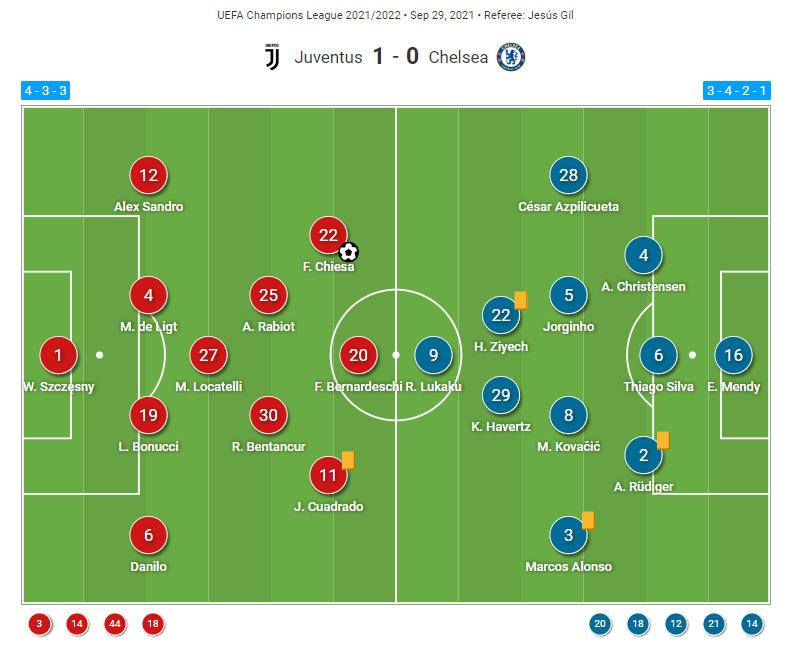
Allegri set the team up in a 4-3-3, with a starting XI that didn’t indicate the defensive focus of their tactics. Wojciech Szczęsny covered the goal with a four-man backline of Alex Sandro, Matthijs De Ligt, Leonardo Bonucci and Danilo.
Manuel Locatelli was assigned to be the connection between the lines while providing additional defensive support. He was surrounded by Adrien Rabiot and Rodrigo Bentancur. Federico Chiesa and Juan Cuadrado covered the wings, while Allegri was forced to rely on Federico Bernardeschi centrally, due to both Alvaro Morata and Paulo Dybala being out injured.
Juventus’ formation was quite fluid with constant changes throughout the game. The team invited the play in their own half and focused on intercepting and recovering the ball, trying to limit the spaces for movement and challenge the ball carrier out of possession. In possession, they looked to engage the Chelsea players in pressing and free up spaces upfront.
On the other side, Tuchel set the team up in a 3-4-2-1 with Edouard Mendy on the goal and a back three of Antonio Rüdiger, Thiago Silva and Andreas Christensen. Marcos Alonso and César Azpilicueta covered the wide areas as wing-backs, while Mateo Kovačić and Jorginho orchestrated the centre-midfield.
Kai Havertz and Hakim Ziyech were placed in front of them as a support to Romelu Lukaku who was the lone striker.
The team focused on their attacking actions with a very highly positioned backline and tried to take advantage of their possession by crossing frequently and trying to find gaps centrally too with a lot of movement and short passing. The lack of concentration and strong decision-making, though, took a toll on them and the opposition managed to counteract.
Juventus’ flexibility and giving away the initiative
It has been difficult for teams to keep up with Chelsea’s tempo and attacking strategy lately as they like to control the games and overload the opposition half with players, creating a high number of opportunities.
Juventus though managed to limit their options and used a fluid approach to be able to keep the Blues away from the goal. With defensively orientated tactics, they completely gave away the initiative, providing Chelsea with plenty of time on the ball, intentionally.
Allegri’s plan was to let the Blues think that they control the game and meanwhile counteract with fluid set-up and smart defensive movement. Instead of risking to leave gaps for the Chelsea players by constantly attacking and trying to score, they occasionally switched between mid and low blocks, adjusting to the opposition’s movement and trying to limit their space for movement.
Their movement and fluid structure allowed them to control the game and stop Chelsea from having a numerical advantage in the advanced areas as per usual.
The team switched between 4-3-3, 4-4-2, 4-1-4-1 and 5-3-2 out of possession, and each of these changes was done with the aim to limit the spaces between the lines, block Chelsea’s passing lanes and force them to their weaker sides. The only constant in Juventus’ defensive movement was always having a defender at Lukaku’s back and limiting his influence on the game.
Juventus’ four-man backline would stay relatively deeper throughout the whole game, providing stability and avoiding leaving spaces for the opposition’s attackers behind.
-
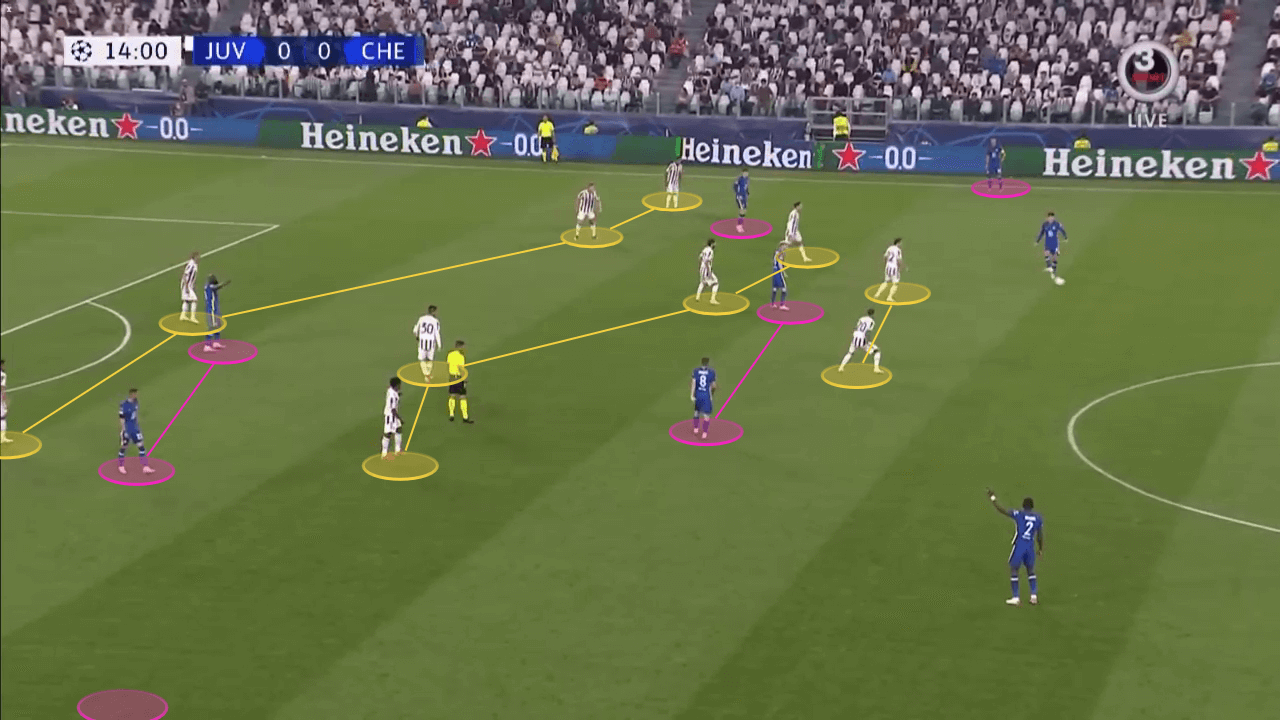
Juve defending in a 4-4-2, limiting the spaces between the lines and trying to isolate the attackers.
The Old Lady had the most control in a 4-1-4-1 mid-low block with a pretty narrow defensive line, so they have equally good control centrally and out wide. This aimed to control the holding midfielders and blocking the passing lanes, but while they focused on that and had Locatelli as additional support there, they allowed plenty of space for Chelsea’s wing-backs on the flanks. Alonso would be joined by one of the attackers and create a numerical advantage in the wide areas.
Juventus quickly had to regroup and would switch between a 4-4-2 and 5-3-2 low block which allowed them to counteract the movement on the flanks but also to keep the space between the lines tight. With Cuadrado helping defensively by following Alonso, Juventus were able to match Chelsea’s numbers in attack and keep them away from having a numerical advantage matching 5vs5 in defence and having the three midfielders blocking the Blues’ double pivot’s movement.
Their average PPDA of 17.94 underlines that they were not interested in direct challenges and intense pressing, but preferred to apply spatial control.
-
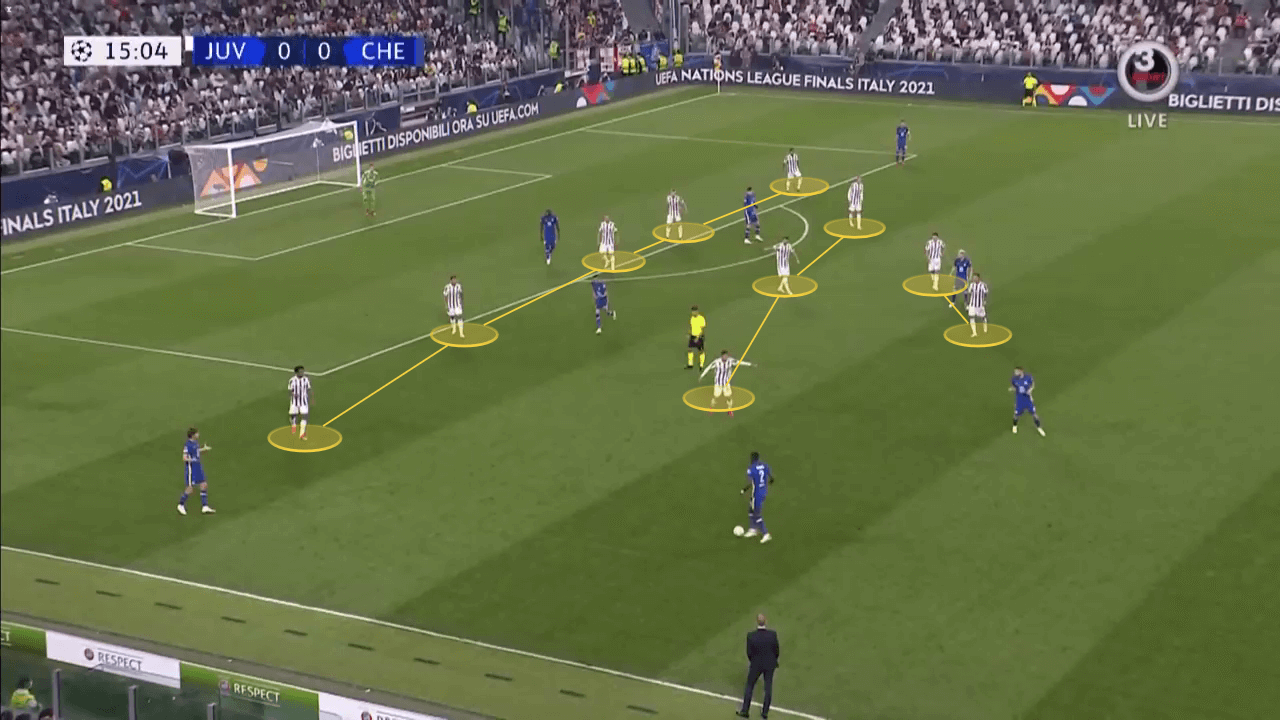
Juve’s 5-3-2 with Cuadrado dropping in defence to cover Alonso. 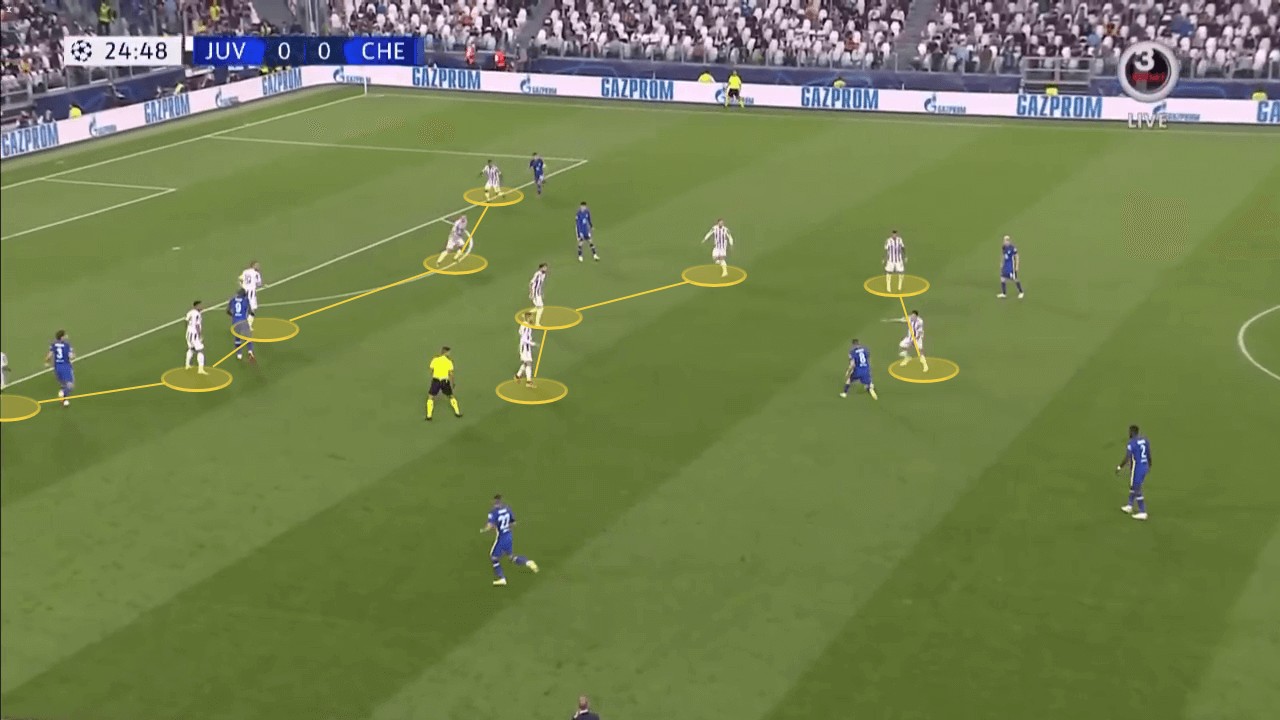
Another example of Allegri’s side defending in a 5-3-2 formation.
Allegri’s side in possession
Expectedly, with this strategy, Juventus didn’t have many chances to attack. The team only completed eight positional attacks and had difficulties breaking through Chelsea’s high press. To adjust to the Blues’ average PPDA rate of 4.12, the Juve players would drop deeper and build-up with five players, involving Szczęsny. They were hesitant to leave any spaces behind the backline, so the whole team stayed relatively deep even in possession.
By their low positioning, they tried to engage the Chelsea midfielders into pressing on a few occasions in aim to open spaces for the forwards in behind. The team also tried to expose the opposition with long balls to the advanced areas and this is actually how the only goal in the game was scored.
They were the most successful in their counter-attacking actions, where they were able to use Chelsea’s high positioning and focus on the attacking actions to expose them. The team managed to expose the highly positioned defensive line on five occasions and produced two of their six shots in the game.
-
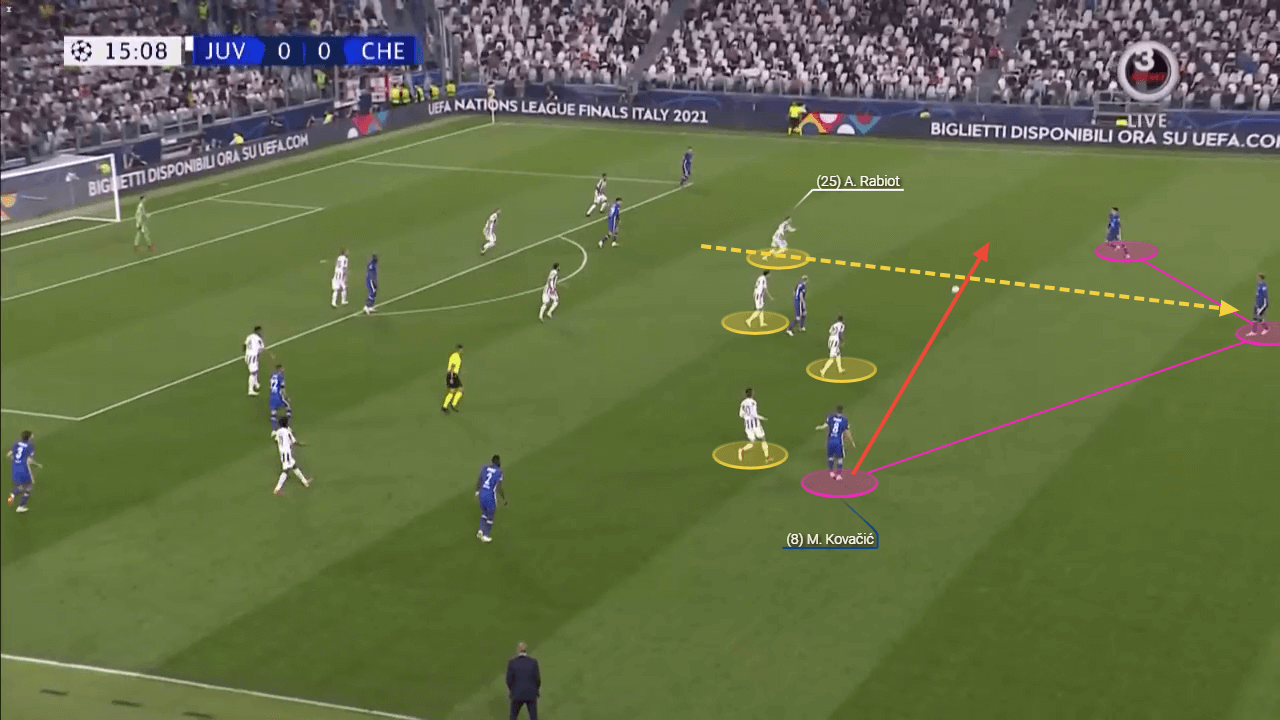
Kovačić made a risky pass and Rabiot immediately saw the opportunity ot intercept and counter-attack. Chelsea’s highly positioned defensive line was numerically matched and it was difficult for them to counteract.
Chelsea’s lack of creativity and concentration
As mentioned, Chelsea was constantly involved in pressing high and trying to limit Juventus’ time on the ball. The attacking players would press on the goalkeeper and the defenders to block their build-up from the back. They would focus on blocking the passing lanes to the full-backs and pressing them, to keep Juve away from attacking through the flanks.
The Londoners defended in a 5-3-2 for the most part, with Lukaku and Havertz often pressing on the defenders, while Ziyech, Jorginho and Kovačić would move into a triangular shape, marking the opposition’s midfielders and matching them numerically. This was also done in an aim to control the central areas and force Juventus to play out wide, where the wing-backs would try to recover the ball.
-
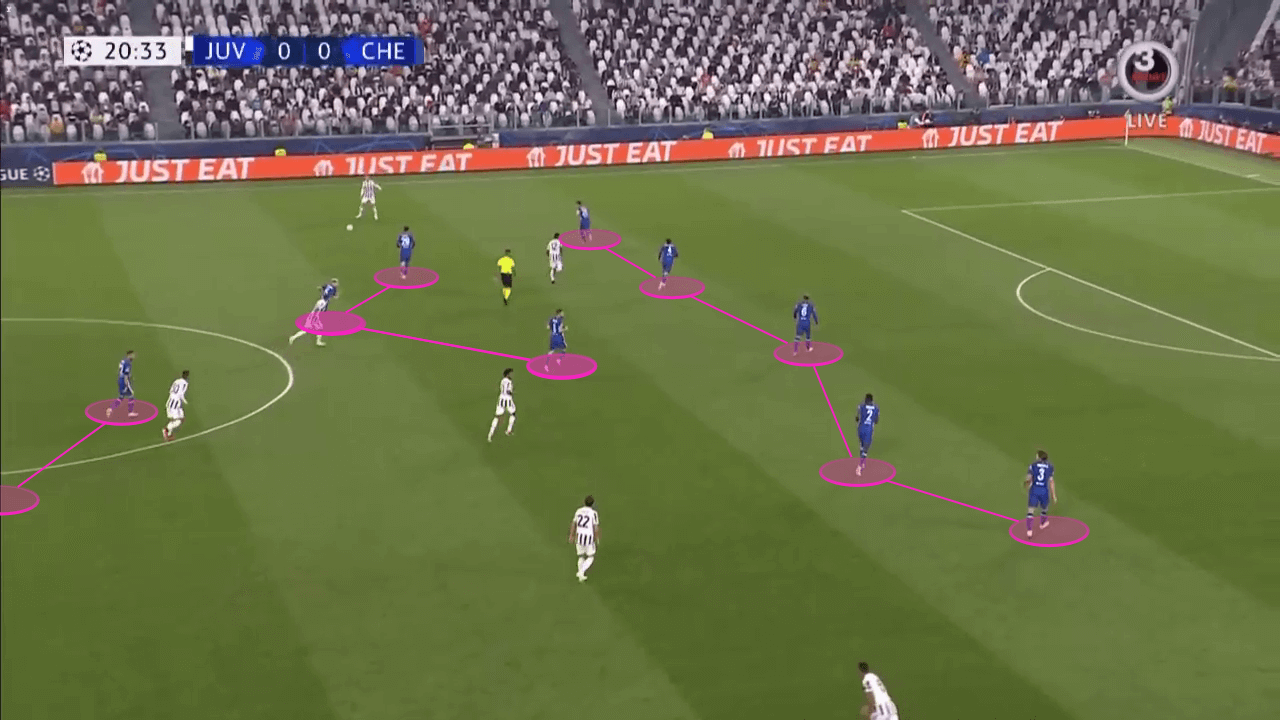
Chelsea’s defensive 5-3-2.
In possession, Chelsea focused on building up from the back and short passing as per usual. The team fell in Juventus’ trap and moved into an advanced position but their passing lanes were limited and the ball was mainly circulated between the centre-backs and the double pivot in front of them.
The team relied on a high crossing frequency, but their actions were highly inaccurate as they often acted hastily and didn’t have the needed concentration. The attacking players would often appear isolated or in poor positions, which kept them away from creating quality chances and shooting on target. The wing-backs had difficulties against Juve’s low-block and were unable to find solutions for the team in attack.
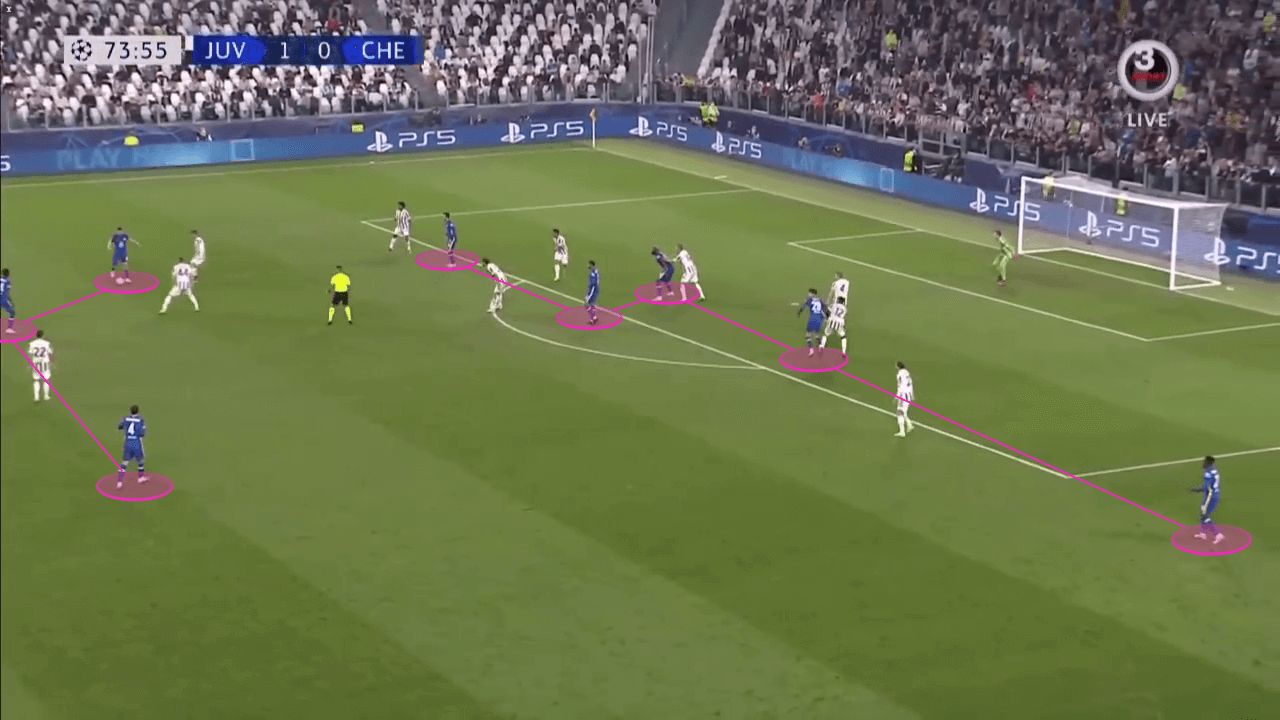
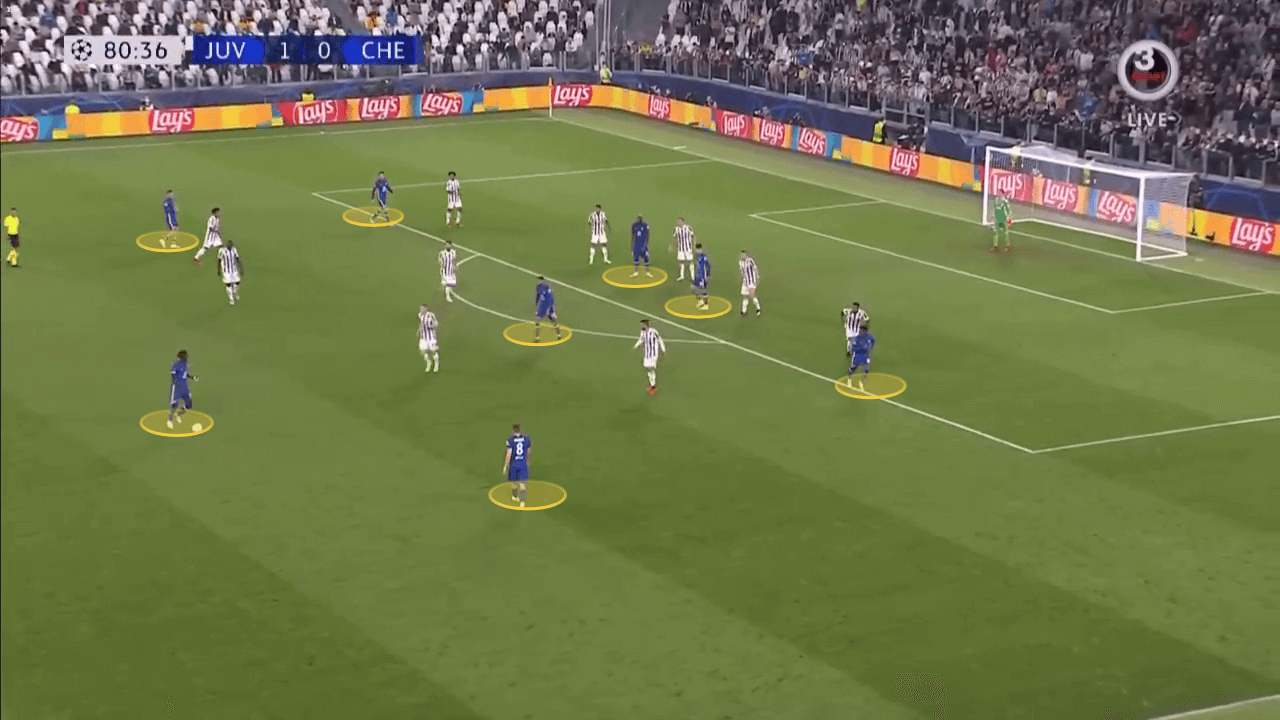
Tuchel tried to increase their creativity and explosiveness by introducing Trevoh Chalobah as a single pivot, Ruben Loftus-Cheek as Kovačić’s partner and Ben Chiwell and Callum Hudson-Odoi as the new wing-backs. This aimed to let Chalobah orchestrate the midfield and distribute the ball to Loftus-Cheek and Kovačić who would move into a more advanced position and support the attacking actions.
Hudson-Odoi did bring more edge on the flank and supported the team with six crossing attempts, managing to move way deeper in the opposition half than Azpilicueta.
-
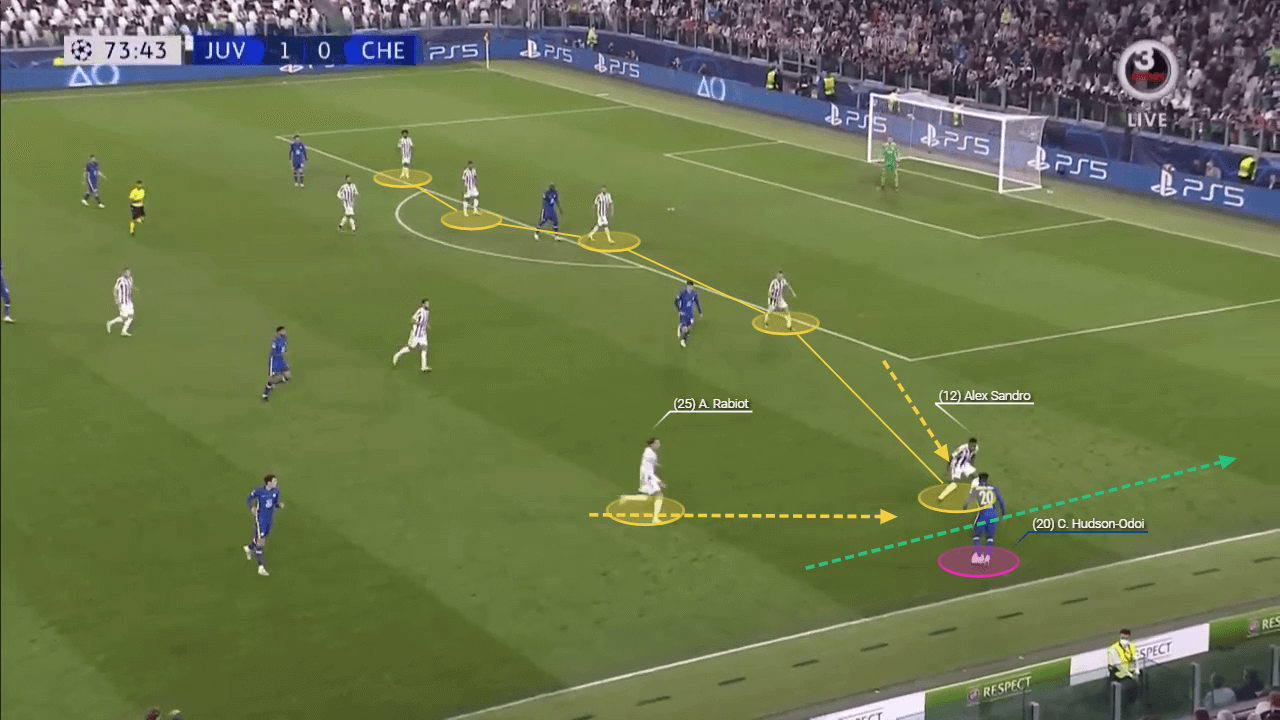
Hudson-Odoi’s presence increased Chelsea’s effectiveness in the wide areas. This image also illustrates how Juventus would close out spaces on the flank involving one defender and one midfielder.
Overall, Chelsea looked disorganised and lacked creativity against the opposition’s mid to low block. Being unable to find empty spaces to exploit forced them to rush on their actions and lose the ball rather often in key moments. Havetz’s poor form added to the frustration as the player’s lack of shooting accuracy (average of 14.3% this season) really affects Chelsea’s efficiency whenever he is given a chance to play.
Conclusion
As our analysis showed, Allegri’s intelligent approach pushed the team to their win over Chelsea and made people question Tuchel’s ability to adjust to the circumstances. While Juventus were flexible enough and prepared for the Blues’ movement, the Londoners didn’t have the needed creativity to break through the opposition’s low block. By risking to play a not very entertaining game, Allegri focused on the team’s defensive actions and managed to get the three points by outwitting his opponent.






Comments